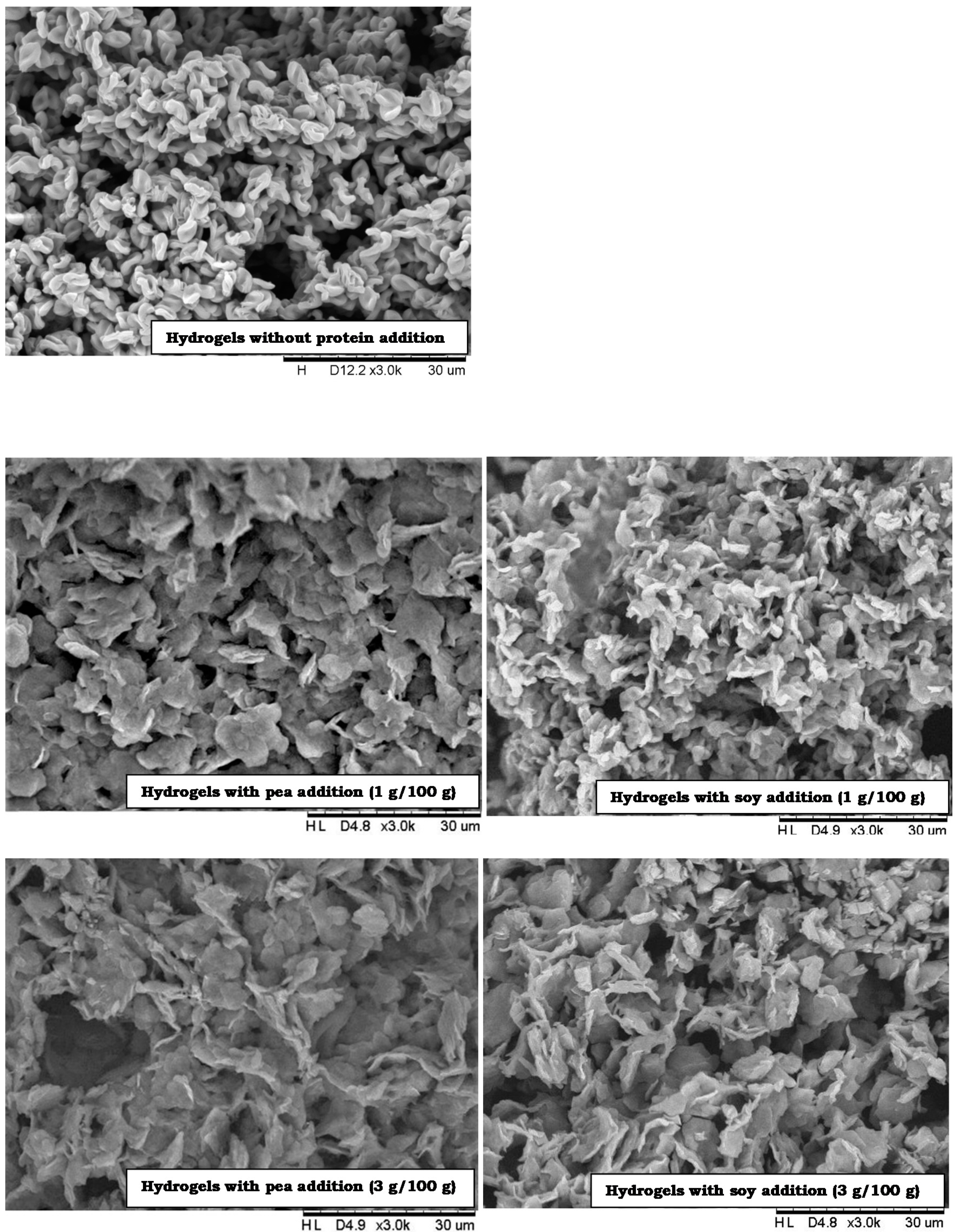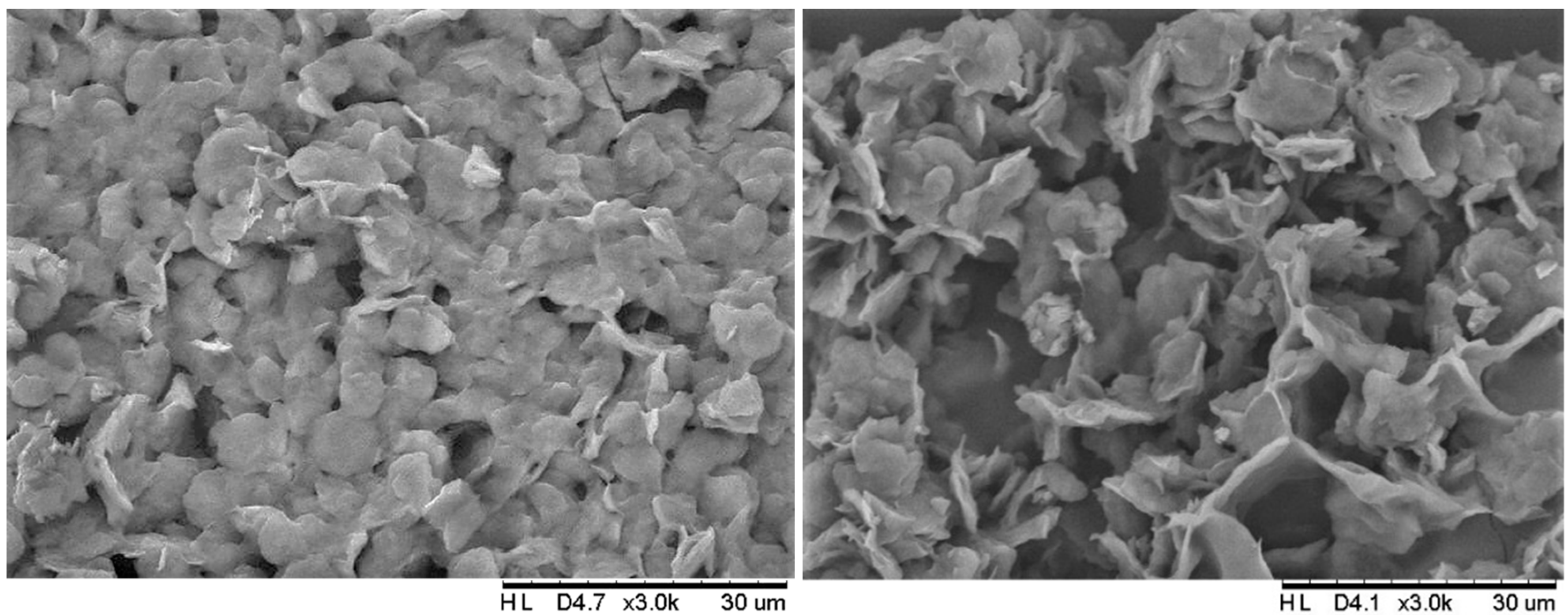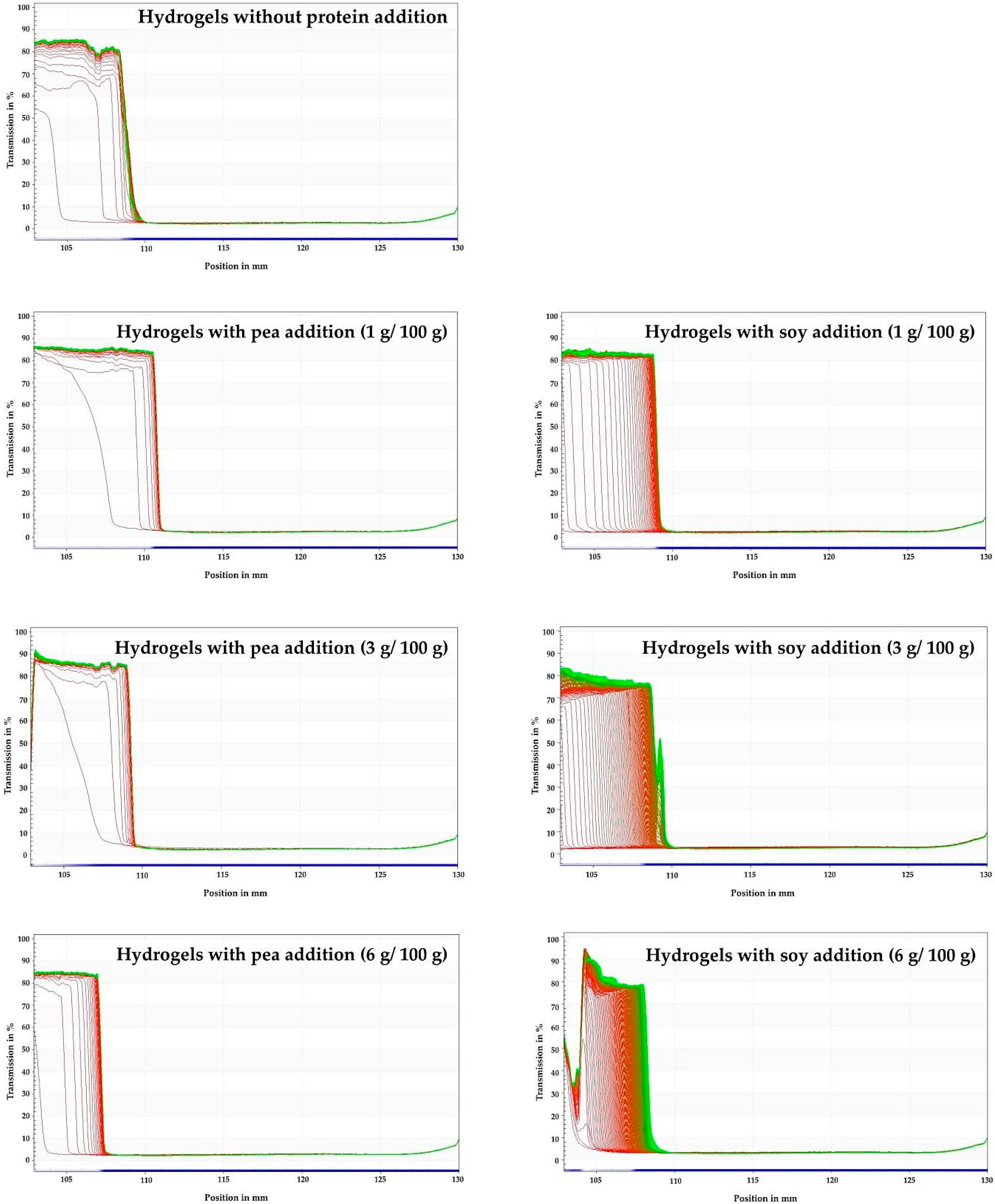Addition of Selected Plant-Derived Proteins as Modifiers of Inulin Hydrogels Properties
Abstract
1. Introduction
2. Materials and Methods
2.1. Materials
2.2. Induction of Inulin Hydrogels
2.3. Methods
2.3.1. Volumetric Gel Index (VGI)
2.3.2. Microstructure
2.3.3. Textural Properties
2.3.4. Yield Stress
2.3.5. Physical Stability
2.3.6. Color Parameters
2.3.7. Statistical Analysis
3. Results and Discussion
3.1. Effect of Soy and Pea Protein Addition on Gel Formation Ability and Microstructure of Inulin Hydrogels
3.2. Effect of Plant Protein Addition on Textural Properties and Yield Stress of Inulin Hydrogels
3.3. Effect of Pea and Soy Protein Addition on Stability of Inulin Hydrogels
3.4. Effect of Pea and Soy Protein Addition on Colour Parameters of Inulin Hydrogels
4. Conclusions
Author Contributions
Funding
Conflicts of Interest
References
- Zhao, M.; Mu, W.; Jiang, B.; Zhou, L.; Zhang, T.; Lu, Z.; Zhengyu, J.; Yang, R. Bioresource Technology Purification and characterization of inulin fructotransferase ( DFA III-forming ) from Arthrobacter aurescens SK 8. 001. Bioresour. Technol. 2011, 102, 1757–1764. [Google Scholar] [CrossRef]
- Florowska, A.; Krygier, K.; Florowski, T.; Dłużewska, E. Prebiotics as functional food ingredients preventing diet-related diseases. Food Funct. 2016, 5, 2147–2155. [Google Scholar] [CrossRef] [PubMed]
- Seifert, A.; Freilich, S.; Kashi, Y.; Liveney, Y.D. Protein oligosaccharide conjugates as novel prebiotics. Polym. Adv. Technol. 2019, 30, 2577–2585. [Google Scholar] [CrossRef]
- Dheer, D.; Arora, D.; Jaglan, S.; Rawal, R.K.; Shankar, R. Polysaccharides based nanomaterials for targeted anti-cancer drug delivery. J. Drug Target. 2017, 25, 1–16. [Google Scholar] [CrossRef]
- Zhang, L.; Pan, J.; Dong, S.; Li, Z. The application of polysaccharide-based nanogels in peptides/proteins and anticancer drugs delivery. J. Drug Target. 2017, 25, 673–684. [Google Scholar] [CrossRef] [PubMed]
- Ghosh, A.K.; Bandyopadhyay, P. Polysaccharide-Protein Interactions and Their Relevance in Food Colloids. In The Complex World of Polysaccharides; Karunaratne, D.N., Ed.; Intech Open: London, UK, 2012; pp. 395–408. [Google Scholar] [CrossRef]
- Behrouzain, F.; Razavi, S.M.A.; Joyner, H. Mechanisms of whey protein isolate interaction with basil seed gum: Influence of pH and protein–polysaccharide, ratio. Carbohydr. Polym. 2020, 232, 115775. [Google Scholar] [CrossRef]
- Turgeon, S.L.; Schmitt, C.; Sanchez, C. Protein – polysaccharide complexes and coacervates. Curr. Opin. Colloid Interface Sci. 2007, 12, 166–178. [Google Scholar] [CrossRef]
- Herceg, Z.; Rezek, A.; Lelas, V.; Kresić, G.; Franetović, M. Effect of carbohydrates on the emulsifying, foaming and freezing properties of whey protein suspensions. J. Food Eng. 2007, 79, 279–286. [Google Scholar] [CrossRef]
- Paraskevopoulou, A.; Athanasiadis, I.; Blekas, G.; Koutinas, A.A.; Kanellaki, M.; Kiosseoglou, V. Influence of polysaccharide addition on stability of a cheese whey kefir-milk mixture. Food Hydrocoll. 2003, 17, 615–620. [Google Scholar] [CrossRef]
- Tavares, C.; Silva, J.A.L. Rheology of galactomannan—Whey protein mixed systems. Int. Dairy J. 2003, 13, 699–706. [Google Scholar] [CrossRef]
- Glibowski, P. Rheological properties and structure of inulin-whey protein gels. Int. Dairy J. 2009, 19, 443–449. [Google Scholar] [CrossRef]
- Shim, J.; Mulvaney, S.J. Effect of heating temperature, pH, concentration and starch / whey protein ratio on the viscoelastic properties of corn starch / whey protein mixed gels. J. Sci. Food Agric. 2001, 81, 706–717. [Google Scholar] [CrossRef]
- Patino, R.J.M.; Pilosof, M.R.A. Protein–polysaccharide interactions at fluid interfaces. Food Hydrocoll. 2011, 25, 1925–1937. [Google Scholar] [CrossRef]
- Dickinson, E. Interfacial structure and stability of food emulsions as affected by protein–polysaccharide interactions. Soft Matter 2008, 4, 932–942. [Google Scholar] [CrossRef]
- Bryant, C.M.; Mc Clements, D.J. Molecular basis of protein functionality with special consideration of cold-set gels derived from heat- denatured whey. Trends Food Sci. Technol. 1998, 9, 143–151. [Google Scholar] [CrossRef]
- Schmitt, C.; Sanchez, C.; Desobry-Banon, S.; Hardy, J. Structure and Technofunctional Properties of Protein–polysaccharide, Complexes: A Review. Crit. Rev. Food Sci. Nutr. 1998, 38, 689–753. [Google Scholar] [CrossRef]
- Zang, X.; Wang, J.; Yu, G.; Cheng, J. Addition of anionic polysaccharides to improve the stability of rice bran protein hydrolysate-stabilized emulsions. LWT Food Sci. Technol. 2019, 111, 573–581. [Google Scholar] [CrossRef]
- Zhang, H.; Fan, Q.; Li, D.; Chen, X.; Liang, L. Impact of gum Arabic on the partition and stability of resveratrol in sunflower oil emulsions stabilized by whey protein isolate. Colloids Surf. B Biointerfaces 2019, 181, 749–755. [Google Scholar] [CrossRef]
- Neves, I.C.O.; de Faria, J.T.; Vidigal, M.C.T.R.; Fidelis, P.C.; Minim, V.P.R.; Minim, L.A. Foaming properties of suspensions composed by β-lactoglobulin and polysaccharides, in the presence of sucrose or polyols. Colloids Surf. A Physicochem. Eng. Asp. 2018, 550, 199–208. [Google Scholar] [CrossRef]
- O’Chiu, E.; Vardhanabhuti, B. Utilizing whey protein isolate and polysaccharide complexes to stabilize aerated dairy gels. J. Dairy Sci. 2017, 100, 3404–3412. [Google Scholar] [CrossRef]
- Cheng, J.; Ma, Y.; Li, X.; Yan, T.; Cui, J. Effects of milk protein–polysaccharide, interactions on the stability of ice cream mix model systems. Food Hydrocoll. 2015, 45, 327–336. [Google Scholar] [CrossRef]
- Schaller-Povolny, L.; Smith, D.E. Interaction of milk proteins with inulin. Milchwissenschaft 2002, 57, 494–497. [Google Scholar]
- Andrès, S.; Zaritzky, N.; Califano, A. The effect of whey protein concentrates and hydrocolloids on the texture and color characteristics of chicken sausages. Int. J. Food Sci. Technol. 2006, 41, 954–961. [Google Scholar] [CrossRef]
- Adebiyi, A.P.; Aluko, R.E. Functional properties of protein fractions obtained from commercial yellow field pea (Pisum sativum L.) seed protein isolate. Food Chem. 2011, 128, 902–908. [Google Scholar] [CrossRef]
- Toews, R.; Wang, N. Physicochemical and functional properties of protein concentrates from pulses. Food Res. Int. 2013, 52, 445–451. [Google Scholar] [CrossRef]
- Chavan, U.D.; Mckenzie, D.B.; Shahidi, F. Protein classification of beach pea (Lathyrus maritimus L.). Food Chem. 2001, 75, 145–153. [Google Scholar] [CrossRef]
- Shevkani, K.; Singh, N.; Kaur, A.; Rana, J.C. Structural and functional characterization of kidney bean and field pea protein isolates: A comparative study. Food Hydrocoll. 2015, 45, 679–689. [Google Scholar] [CrossRef]
- Mounts, T.L.; Wolf, W.J.; Martinez, W.H. Processing and utilization. In Soybeans: Improvement, Production, and Uses, 2nd ed.; Wilcox, J.R., Ed.; The American Society of Agronomy: Madison, WI, USA, 1987; pp. 819–860. [Google Scholar]
- Alibhai, Z.; Mondor, M.; Moresoli, C.; Ippersiel, D.; Lamarche, F. Production of soy protein concentrates isolates: Traditional and membrane technologies. Desalination 2006, 191, 351–358. [Google Scholar] [CrossRef]
- Zhang, H.; Mittal, G. Biodegradable protein-based films from plant resources: A review. Environ. Prog. Sustain. Energy 2010, 29, 203–220. [Google Scholar] [CrossRef]
- Renkema, J.M.S.; Knabben, J.H.M.; Van Vliet, T. Gel formation by β -conglycinin and glycinin and their mixtures. Food Hydrocoll. 2001, 15, 407–414. [Google Scholar] [CrossRef]
- Berghout, J.A.M.; Boom, R.M.; van der Goot, A.J. Understanding the differences in gelling properties between lupin protein isolate and soy protein isolate. Food Hydrocoll. 2015, 43, 465–472. [Google Scholar] [CrossRef]
- Wan, Z.L.; Wang, L.Y.; Yang, X.Q.; Wang, J.M.; Wang, L.J. Controlled formation and stabilization of nanosized colloidal suspensions by combination of soy protein and biosurfactant stevioside as stabilizers. Food Hydrocoll. 2016, 52, 317–328. [Google Scholar] [CrossRef]
- Du, M.; Xie, J.; Gong, B.; Xu, X.; Tang, W.; Li, X.; Li, C.; Xie, M. Extraction, physicochemical characteristics and functional properties of Mung bean protein. Food Hydrocoll. 2018, 76, 131–140. [Google Scholar] [CrossRef]
- Feyzi, S.; Milani, E.; Golimovahhed, Q.A. Grass Pea (Lathyrus sativus L.) Protein Isolate: The Effect of Extraction Optimization and Drying Methods on the Structure and Functional Properties. Food Hydrocoll. 2018, 74, 187–196. [Google Scholar] [CrossRef]
- Bajaj, P.R.; Tang, J.; Sablani, S.S. Pea Protein Isolates: Novel Wall Materials for Microencapsulating Flaxseed Oil. Food Bioprocess Technol. 2015, 8, 2418–2428. [Google Scholar] [CrossRef]
- Chao, D.; Jung, S.; Aluko, R.E. Physicochemical and functional properties of high pressure-treated isolated pea protein. Innov. Food Sci. Emerg. Technol. 2018, 45, 179–185. [Google Scholar] [CrossRef]
- Peng, W.; Kong, X.; Chen, Y.; Zhang, C.; Yang, Y.; Hua, Y. Effects of heat treatment on the emulsifying properties of pea proteins. Food Hydrocoll. 2016, 52, 301–310. [Google Scholar] [CrossRef]
- Klemmer, K.J.; Waldner, L.; Stone, A.; Low, N.H.; Nickerson, M.T. Complex coacervation of pea protein isolate and alginate polysaccharides. Food Chem. 2012, 130, 710–715. [Google Scholar] [CrossRef]
- Kowalczyk, D.; Baraniak, B. Effects of plasticizers, pH and heating of film- forming solution on the properties of pea protein isolate films. J. Food Eng. 2011, 105, 295–305. [Google Scholar] [CrossRef]
- Salunkhe, S.S.; Kadam, D.K. (Eds.) Handbook of World Food Legumes: Nutritional Chemistry, Processing Technology, and Utilization; CRC Press, Inc.: Boca Raton, FL, USA, 1989; pp. 1–4. [Google Scholar]
- Liang, H.N.; Tang, C.H. pH-dependent emulsifying properties of pea (Pisum sativum L.) proteins. Food Hydrocoll. 2013, 33, 309–319. [Google Scholar] [CrossRef]
- Gatehouse, J.A.; Lycett, W.; Croy, R.R.D.; Boulter, D. The post-translational proteolysis of the subunits of vicilin from pea (Pisum sativum L). Biochem. J. 1982, 207, 629–632. [Google Scholar] [CrossRef] [PubMed]
- Reinkensmeier, A.; Bußler, S.; Schlüter, O.; Rohn, S.; Rawel, H.M. Characterization of individual proteins in pea protein isolates and air classified samples. Food Res. Int. 2015, 76, 160–167. [Google Scholar] [CrossRef]
- Lam, A.C.Y.; Can Karaca, A.; Tyler, R.T.; Nickerson, M.T. Pea protein isolates: Structure, extraction, and functionality. Food Rev. Int. 2018, 34, 126–147. [Google Scholar] [CrossRef]
- Aluko, R.E.; Mofolasayo, O.A.; Watts, B.M. Emulsifying and foaming properties of commercial yellow pea (Pisum sativum L.) seed flours. J. Agric. Food Chem. 2009, 57, 9793–9800. [Google Scholar] [CrossRef]
- Taherian, A.R.; Mondor, M.; Labranche, J.; Drolet, H.; Ippersiel, D.; Lamarche, F. Comparative study of functional properties of commercial and membrane processed yellow pea protein isolates. Food Res. Int. 2011, 44, 2505–2514. [Google Scholar] [CrossRef]
- Arntfield, S.D.; Maskus, H.D. 9-Peas and other legume proteins. Handb. Food Proteins 2011, 1, 233–266. [Google Scholar] [CrossRef]
- Kowalczyk, W.; Gustaw, M.; Swieca, B.; Baraniak, A. study on the mechanical properties of pea protein isolate films. J. Food Process. Preserv. 2014, 38, 1726–1736. [Google Scholar] [CrossRef]
- Kim, Y.; Faqih, M.N.; Wang, S.S. Factors affecting gel formation of inulin. Carbohydr. Polym. 2001, 46, 135–145. [Google Scholar] [CrossRef]
- Mokrzycki, W.S.; Tatol, M. Color difference ΔE—A survey. Mach. Graph. Vis. 2011, 20, 383–411. [Google Scholar]
- Picone, C.S.F.; Maximo, G.J.; Kuhn, K.R.; Ros-Polski, V.; Cunha, R.L. An assessment of the texture of acidified sodium caseinate gels with added inulin using response surface methodology. Int. J. Dairy Technol. 2011, 64, 353–359. [Google Scholar] [CrossRef]
- Turgeon, S.L.; Beaulieu, M. Improvement and modification of whey protein gel texture using polysaccharides. Food Hydrocoll. 2001, 15, 583–591. [Google Scholar] [CrossRef]
- Fukushima, D. Recent progress in research and technology on soybeans. Food Sci. Technol. Res. 2001, 7, 8–16. [Google Scholar] [CrossRef]
- Buriti, F.C.A.; Castro, I.A.; Saad, S.M.I. Effects of refrigeration, freezing and replacement of milk fat by inulin and whey protein concentrate on texture profile and sensory acceptance of synbiotic guava mousses. Food Chem. 2010, 123, 1190–1197. [Google Scholar] [CrossRef]
- Glibowski, P. Effect of inulin on rheological properties of whey protein solutions. Acta Agrophysica 2006, 8, 337–345. [Google Scholar]
- Akal, Â.; Karagözlü, C.; Ünal, G. Rheological properties of reduced-fat and low-fat ice cream containing whey protein isolate and inulin. Eur. Food Res. Technol. 2008, 227, 889–895. [Google Scholar] [CrossRef]
- Adhikari, B.; Howes, T.; Bhandari, B.R.; Truong, V. In situ characterization of stickiness of sugar-rich foods using a linear actuator driven stickiness testing device. J. Food Eng. 2003, 58, 11–22. [Google Scholar] [CrossRef]
- Kopeček, J.; Yang, J. Hydrogels as smart biomaterials. Polym. Int. 2007, 56, 1078–1098. [Google Scholar] [CrossRef]
- Tárrega, A.; Costell, E. Effect of inulin addition on rheological and sensory properties of fat-free starch-based dairy desserts. Int. Dairy J. 2006, 16, 1104–1112. [Google Scholar] [CrossRef]
- Van Den Berg, L.; Van Vliet, T. Physical Properties Giving the Sensory Perception of Whey Proteins/Polysaccharide Gels. Food Biophys. 2008, 3, 198–206. [Google Scholar] [CrossRef]
- Hunter, R. Foundations of Colloid Science; Clarendon Press: Oxford, UK, 2001; pp. 66–69. [Google Scholar]
- Berli, C.L.A.; Deiber, J.A.; Añón, M.C. Connection between rheological parameters and colloidal interactions of a soy protein suspension. Food Hydrocoll. 1999, 13, 507–515. [Google Scholar] [CrossRef]
- Ikeda, S.; Nishinari, K. Weak Gel-Type Rheological Properties of Aqueous Dispersions of Non aggregated k-Carrageenan Helices. J. Agric. Food Chem. 2001, 49, 4436–4441. [Google Scholar] [CrossRef] [PubMed]
- Zha, F.; Dong, S.; Rao, J.; Chen, B. Pea protein isolate-gum Arabic Maillard conjugates improves physical and oxidative stability of oil-in-water emulsions. Food Chem. 2019, 285, 130–138. [Google Scholar] [CrossRef] [PubMed]
- Florowska, A.; Florowski, T.; Sokołowska, B.; Janowicz, M.; Adamczak, L.; Pietrzak, D. Effect of high hydrostatic pressure on formation and rheological properties of inulin gels. LWT Food Sci. Technol. 2020, 121, 108995. [Google Scholar] [CrossRef]
- Tobin, J.T.; Fitzsimons, S.M.; Kelly, A.L.; Philip, M.; Auty, M.A.E.; Fenelon, M.A. Microparticulation of mixtures of whey protein and inulin. International J. Dairy Technol. 2010, 63, 32–40. [Google Scholar] [CrossRef]
- Tseng, Y.; Xiong, Y.L.; Boatright, W.L. Effects of Inulin / Oligofructose on the Thermal Stability and Acid-Induced Gelation of Soy Proteins. J. Food Sci. 2008, 73, E44–E50. [Google Scholar] [CrossRef]
- Galus, S.; Mathieu, H.; Lenart, A.; Debeaufort, F. Effect of modified starch or maltodextrin incorporation on the barrier and mechanical properties, moisture sensitivity and appearance of soy protein isolate-based edible films. Innov. Food Sci. Emerg. Technol. 2012, 16, 148–154. [Google Scholar] [CrossRef]
- Sun, W.; Xiong, Y.L. Stabilization of cooked cured beef color by radical-scavenging pea protein and its hydrolysate. LWT Food Sci. Technol. 2015, 61, 352–358. [Google Scholar] [CrossRef]
- Parmar, N.; Singh, N.; Kaur, A.; Virdi, A.S.; Thakur, S. Effect of canning on color, protein and phenolic profile of grains from kidney bean, field pea and chickpea. Food Res. Int. 2016, 89, 526–532. [Google Scholar] [CrossRef]
- Pérez, S.; Matta, E.; Osella, C.; De la Torre, M.; Sánchez, H.D. Effect of soy flour and whey protein concentrate on cookie color. LWT Food Sci. Technol. 2013, 50, 120–125. [Google Scholar] [CrossRef]




| Concertation of Protein [g/100 g] | VGI [%] | Firmness [N] | Adhesiveness [Ns] | Spreadability [N] | Yield Stress [Pa] | Instability Index | |
|---|---|---|---|---|---|---|---|
| Control | 0 | 100 a | 0.24 a ± 0.02 | −0.10 a ± 0.01 | 2.43 a ± 0.12 | 195.0 a ± 8.0 | 0.53 c ± 0.04 |
| Pea protein | 1 | 100 a | 0.35 ab ± 0.12 | −0.11 a ± 0.00 | 2.45 a ± 0.44 | 271.3 b ± 26.5 | 0.57 c ± 0.03 |
| 3 | 100 a | 0.56 bc ± 0.14 | −0.17 a ± 0.00 | 3.38 b ± 0.27 | 448.0 c ± 25.5 | 0.36 b ± 0.09 | |
| 6 | 100 a | 1.87 d ± 0.09 | −0.44 b ± 0.04 | 9.23 c ± 0.20 | 1644.7 e ± 34.4 | 0.35 b ± 0.01 | |
| Soy protein | 1 | 100 a | 0.47 abc ± 0.07 | −0.13 a ± 0.01 | 3.55 b ± 0.09 | 237.3 ab ± 24.1 | 0.56 c ± 0.01 |
| 3 | 100 a | 0.76 c ± 0.02 | −0.17 a ± 0.02 | 6.00 c ± 0.04 | 564.7 d ± 7.0 | 0.54 c ± 0.02 | |
| 6 | 100 a | 2.60 e ± 0.20 | −1.26 c ± 0.16 | 21.74 e ± 0.28 | 1746.0 f ± 38.0 | 0.15 a ± 0.03 |
| Concertation of Protein [g/100 g] | Color Parameters | ΔE # | |||
|---|---|---|---|---|---|
| L* | a* | b* | |||
| Control | 0 | 87.89 a ± 1.45 | −0.73 a ± 0.33 | 2.50 a ± 0.35 | - |
| Pea protein | 1 | 86.22 b ± 0.07 | −0.24 b ± 0.03 | 3.65 b ± 0.04 | 2.18 ± 0.77 |
| 3 | 82.38 c ± 0.15 | 0.68 c ± 0.01 | 9.40 d ± 0.21 | 8.97 ± 0.96 | |
| 6 | 79.04 d ± 0.05 | 1.34 d ± 0.01 | 12.55 f ± 0.03 | 13.56 ± 0.86 | |
| Soy protein | 1 | 86.29 b ± 0.05 | −0.83 a ± 0.11 | 5.43 c ± 0.01 | 3.40 ± 0.67 |
| 3 | 80.78 c ± 0.09 | −0.26 b ± 0.13 | 9.85 e ± 0.06 | 10.25 ± 0.90 | |
| 6 | 80.27 c ± 0.17 | −0.03 b ± 0.01 | 12.40 f ± 0.13 | 12.54 ± 0.82 | |
© 2020 by the authors. Licensee MDPI, Basel, Switzerland. This article is an open access article distributed under the terms and conditions of the Creative Commons Attribution (CC BY) license (http://creativecommons.org/licenses/by/4.0/).
Share and Cite
Florowska, A.; Hilal, A.; Florowski, T.; Wroniak, M. Addition of Selected Plant-Derived Proteins as Modifiers of Inulin Hydrogels Properties. Foods 2020, 9, 845. https://doi.org/10.3390/foods9070845
Florowska A, Hilal A, Florowski T, Wroniak M. Addition of Selected Plant-Derived Proteins as Modifiers of Inulin Hydrogels Properties. Foods. 2020; 9(7):845. https://doi.org/10.3390/foods9070845
Chicago/Turabian StyleFlorowska, Anna, Adonis Hilal, Tomasz Florowski, and Małgorzata Wroniak. 2020. "Addition of Selected Plant-Derived Proteins as Modifiers of Inulin Hydrogels Properties" Foods 9, no. 7: 845. https://doi.org/10.3390/foods9070845
APA StyleFlorowska, A., Hilal, A., Florowski, T., & Wroniak, M. (2020). Addition of Selected Plant-Derived Proteins as Modifiers of Inulin Hydrogels Properties. Foods, 9(7), 845. https://doi.org/10.3390/foods9070845








